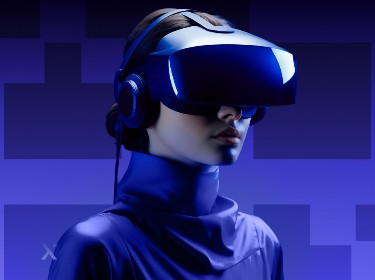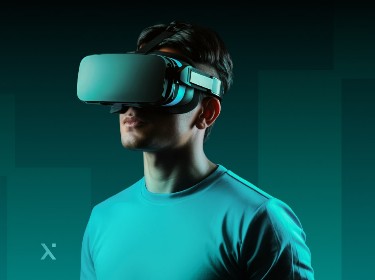Augmented Reality and Virtual Reality are playing a progressive role in modernizing the marketing and sales landscape of the real estate industry. While technology alone cannot sell homes or furniture, it’s certainly leading to quicker property transactions and enhancing customer experience.
Immersive Technologies, comprising Augmented Reality (AR), Virtual Reality (VR), and Mixed Reality (MR), are proving revolutionary. They are among today’s fastest-growing and most fascinating technologies, rapidly gaining momentum.
AR/VR solutions have found ample applications in a range of domains, from gaming to social media applications and even healthcare, transportation, construction, and more. These technologies are also edging into the real estate industry.
A study conducted by Goldman Sachs estimated that the market for VR in Real Estate will generate approximately $2.6 billion by 2025, with around 130,000 real estate agents already using VR to show homes. Undoubtedly, AR/VR technology in Real Estate is attracting sizable financial investments.
Before we look at how AR and VR in real estate applications have reshaped the real estate market, let’s first understand what they are.
What are AR and VR technologies?
AR and VR technologies extend or create realities by immersing the user in a digital environment. Individually, we can explain these as follows.
Augmented reality
AR technology overlays digital content on top of the real world. Accessing the technology through a smartphone, AR users can control their real-world presence. The most common and practical examples of the potential of AR development services are the use of Snapchat Filters and catching a pokemon through the Pokemon Go app.
Virtual reality
Virtual Reality Technology replaces reality with an entirely new 3D, digitally simulated environment. By wearing a headset device, VR users immerse themselves into a fictional form of reality, allowing the system to completely control their minds. A common VR usage example is ClassVR, where VR headsets are used in the classroom to increase engagement and improve knowledge retention among students of all ages.
How does real estate fit in?
Interestingly, GrandViewResearch has estimated a CAGR of 43.8% for the Global AR Market between 2020-2028. Also, research conducted by Mordor Intelligence estimated a CAGR of 48.7% for the Global VR Market between 2020-2026.
The numbers only hint at how disruptive these technologies can prove to be in any industry — and that includes real estate. AR/VR is changing all processes, right from the initial designing to trading and managing properties.
AR/VR in the real estate industry
![]()
Traditionally, potential buyers had to visit homes and spaces, making the entire process very lengthy and often tedious. With advancements in technology, realtors adopted digitalization in the form of websites and social media profiles.
But with the arrival of AR and VR technologies, the sales and marketing landscape of the real estate industry has been transformed. AR/VR applications have simplified and improved the traditional home renting, buying and selling processes.
Virtual tours
AR/VR technology in Real Estate enables prospective buyers to visit multiple properties from anywhere, at any time, using a VR headset. Virtual Reality Home Tours offer ease and convenience for both buyers and agents by saving the time, effort and money otherwise spent in physically visiting properties. VR Tours can broadly be of two types:
- Guided tours basically take the form of pre-recorded videos, made using a panoramic camera. It creates a 360-degree video of the property without much-sophisticated rendering or programming, to be viewed using a VR Headset.
- Interactive tours allow users to interact and get more involved in the virtual reality home tour. Users can choose where to move around, interacting with elements using specific hotspots in their field of view. These tours are undoubtedly more efficient than guided tours but are a lot more complicated to create.
With an expert VR development company, big names like Zillow and Sotheby’s Real Estate have successfully integrated Virtual Reality Home Tours for their clients as part of their service offerings.
See a case study of a VR Platform for generating 360° virtual tours for properties
Virtual staging
Virtual staging involves creating an interior design for vacant spaces using graphic editors, allowing clients to visualize the property. Realtors use AR/VR technology to stage homes and create realistic images of properties that are up for sale. This cuts down costs associated with traditional staging and offers customization opportunities to match the clients’ preferences.
Architectural visualization
Virtual Reality in real estate has considerably simplified the process of marketing homes that are yet to be built. Traditionally, 3D models of buildings or complexes helped clients visualize potential constructions. Similarly, real estate agents set up costly showrooms displaying an apartment’s interiors for marketing purposes.
VR/AR technology offers a cheap yet highly immersive alternative. Similarly, Architectural Visualization allows prospective buyers to inspect interiors and exteriors of properties that don’t yet exist.
Architectural Visualization also plays a significant role in the Hospitality Industry. Hospitality Visualizations incorporate 3D animations to provide an interactive VR tour of the interior and exterior, thereby promising a holistic hotel design.
Virtual advice for tenants
VR in real estate simplifies communication between landlords and tenants. Traditional communication may seem straightforward, but it gets messy and tedious under the weight of repeated demands, as can often be the case with vacation homes.
VR technology offers virtual reality home tours for the tenants. Landlords can also share maintenance instructions using VR headsets. In a nutshell, VR enables tenants to learn every detail about the property’s interior and exterior before arriving. The result is that the landlord is freed from the hassle of providing instructions multiple times.
Virtual commerce
This application is an extension of VR Home Tours and Staging. It allows potential homebuyers to visit online stores and make modifications to elements in their VR tours. Clients can choose and compare new pieces of furniture or design items in the VR headset.
It offers a thoroughly immersive and personalized experience. Customers can also purchase pieces showcased in the VR tours. For example, Houzz, a real estate application using AR technology, allows users to choose, view, and purchase from over 10 million products. It also helps clients connect with experts such as architects and interior designers for assistance.
The key point is that AR/VR in real estate applications helps prospective buyers gauge their emotional appeal or ‘feel’ towards a property, thereby easing the decision-making process. It also aids sellers and agents in their marketing efforts.
Adoption of AR/VR in real estate: benefits
![]()
The benefits of using AR/VR can be broadly understood as follows:
- Cost-effectiveness. Real Estate AR/VR eliminates substantial traditional marketing costs, such as the cost of staging a property, thereby offering a better ROI to the agents and sellers. It also cuts down traveling expenses for prospective buyers, especially for those coming from further away.
- Wider geographic/global reach. Prospective buyers can now view properties virtually, from anywhere in the world. With the help of AR/VR, neither buyers nor real estate professionals have to restrict their reach to local markets.
- Enhanced customer experience. The AR/VR technology in real estate offers customers an immersive real-life experience of the property. It helps them to not only visualize the property but also to form a deep connection with their potential home-to-be. Moreover, virtual staging allows clients to personalize the interiors. The whole process enhances the client’s overall satisfaction.
- Saved time resources. Agents no longer need to schedule visits or stage properties for marketing houses. They can virtually deal in rural and remote properties from the comfort of their home and office. Similarly, buyers can save traveling time and effort.
- Quicker deal turnouts. Virtual reality home tours and staging enable prospective buyers to get a feel of the property. The decision-making process is simplified. Consequently, agents see quicker property transactions and reduced sale cycle time.
- Competitive advantage. The adoption of advanced technology offers a unique differentiating factor to the real estate company and agent. It provides a competitive advantage by highlighting one’s profile over others in the same industry.
Read the story on an Oculus Go VR hospitality virtual tour solution
Adoption of AR/VR in real estate: limitations
It is important to look at some pressing challenges involved in the adoption of AR/VR in the real estate industry. Let’s go over some of the major concerns.
Resistance to advanced technology
One major limitation to the adoption of AR/VR is the general resistance that many people have when it comes to adopting new and advanced technology. People assume advanced technology to be complicated to use. Buyers may therefore be doubtful of AR/VR technology in real estate and prefer to visit the property personally.
Health and sanitation concerns
Customers may not support the idea of sharing VR headsets with unknown people, fearing contamination. Additionally, VR headsets may cause nausea or dizziness among some, especially older clients.
Concerns about data privacy and security
The adoption of AR/VR Technology requires the real estate company to share all sensitive information and ideas related to the virtual project with the VR creator. This exposes the company to a new wave of potential risks with regard to data security and the privacy of sensitive information related to their employees, tenants or vendors.
Large capital expenditure
Investment in real estate AR/VR technology is a huge capital expenditure. Over the long term, this investment can prove to be cost-effective and profitable, given low maintenance and zero salvage cost. However, from a short-term perspective, the investment is hefty. For companies struggling with liquidity, implementing this technological shift can be difficult.
AR/VR in real estate applications: process, costs, and time
![]()
Simple web applications or real estate company websites have become mundane. Everyone is already familiar with real-estate apps offering purchase or renting of houses, property management, home valuation, and other support to real estate agents. However, the AR/VR technology in real estate applications is comparatively new and shows a very promising future growth potential.
You might well be wondering how a real-estate application with virtual reality features is developed? If you’re looking to jump-start a project, we strongly advise you to consider partnering with a software development company. The application development process can be very different for every case, depending on the goals and approach taken. We’ll try to give you a brief overview below.
AR/VR real estate app development planning
First of all, the real estate software development services company needs to conduct thorough market research to understand competitors’ models and the existing market gaps. Then they need to prepare documentation mentioning the purpose, features, and VR content offered in their particular app.
The VR content can be of two types. Firstly, it can showcase 3D graphics of unfinished projects for marketing. Secondly, it can provide a virtual staging interior and exterior of finished projects, through 360-degree videos, without creating an actual model.
Though a fully immersive interactive VR application would deliver the best results, it brings with it higher costs and lengthier time frames. At the end of this stage, the real estate company should have a clear picture of the features, ideas, and VR content offered.
Implementing the AR/VR application
The process of implementing your AR/VR real estate app has its own twists and turns that impact the quality of provided experience, as well as the cost and time of development. Let’s explore what you might encounter.
Web vs. native application. Native applications are developed for both Android and iOS platforms individually, which requires allocating two teams of experts. A web application is cross-platform and less costly to develop, however, it may have some limitations in terms of functionality. The decision needs to be made on a case-to-case basis after consulting with a qualified software developer.
VR equipment selection. Decisions related to the hardware to be adopted directly affect the total cost of the application development. The best way is to choose VR/AR features that can run on every smartphone and be viewed through a VR viewer like Google Cardboard.
However, equipment such as VR Headsets that offer high-quality images and interaction is always costlier. The most advanced VR Headsets are manufactured by Oculus and Microsoft HoloLens. The price of these ranges from $299 to $999.
UI/UX design. The UI Design has to be simple yet attractive. It is crucial for AR/VR real estate applications to be user-friendly. Sacrificing time and money on design could later backfire in lower app usage statistics and seriously hurt your return on investment.
Creating and putting together visual content. The visual content for the Virtual Reality Home Tour or Staging has to be provided by the real estate company. The developers are then responsible for linking these high-quality panoramic images in a tour flow and rendering a 360-degree video out of them.
The videos are then processed and connected to create a 3D virtual space which becomes the main content of the VR application. This is sometimes a very time-consuming process and involves the work of highly qualified experts in 3D design, animation, and editing.
Menu development and other features. Every VR application requires a menu to help guide interactions between the users and the immersive environment. Other traditional application features like social media integration, user profiles, push notifications, and so on are also relevant and add up to the overall development costs.
Backend development. Every application needs the basic set of backend functionality: server, database, user authentication, and security mechanisms. Developing and implementing the backend needs serious dedication and expertise. This is the backbone of your application which connects all the functional elements and lets them communicate with each other.
Quality assurance and deployment. To ensure the best quality of VR Content and the app’s functionality, developers and quality assurance engineers must conduct both manual and automated tests. Oftentimes, these tests are tightly interwoven with feature development and follow crucial milestones in the app’s build process.
The final stage involves deployment, promotion, and distribution. The costs here vary depending on the target audience, type of VR application created, and the promotion channel adopted.
Overall, the entire process may take up anything from several months to a year. The more time you invest in the project, the higher the returns on your investment. The costs and additional expenses range from $25,000 and in some cases may go as high up as a few hundred thousand dollars, or even higher, depending on the complexity involved.
AR/VR in real estate: future growth prospects?
![]()
We can definitely expect an expansion of AR/VR in the real estate industry, as investors are incessantly pouring funds into property-related technology (Proptech). The real estate sector has already shown it is open to incorporating technology, and AR/VR is the next big thing.
Currently, AR in real estate applications is gauging more interest than VR among realtors. The reason being that AR technology is easily accessible using smartphones and tablets.
On the other hand, VR in real estate applications requires special VR headsets that are not as affordable as regular mobile devices. As VR technology becomes more cost-effective and user-friendly, we can expect its increased adoption in the real estate market.
Lastly, scientists are working towards simulating taste, smell and touch through VR/AR. The day is not far off when a VR Tour will feel almost like a physical property visit.
Conclusion
The real estate industry is one of the top use cases for AR/VR experiences. It allows real estate agents to create guided virtual tours and let buyers explore their properties from the convenience of their homes. Agents are also able to create a much deeper immersion, giving users the chance to experiment with interior design and decorations.
In residential real estate, offering such virtual tours can greatly shorten the time for clients to make a decision on the purchase of a house or an apartment lease. An AR/VR real estate app could be a large investment, but it definitely offers a service provider both short-term and long-run benefits in costs and expenses.
A real estate company has much experience in presenting properties, showcasing, and highlighting attractive attributes. Agents should be responsible for scripting and choosing the content for a virtual tour. An experienced full-cycle AR/VR software development company, on the other hand, can guide real estate providers through the technicalities of capturing 360-degree digital content and putting all the pieces together to create the best AR/VR experience.




